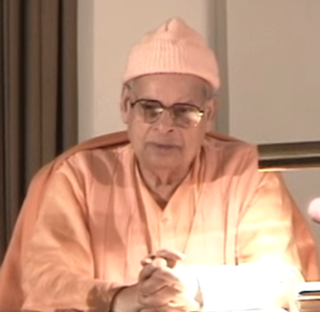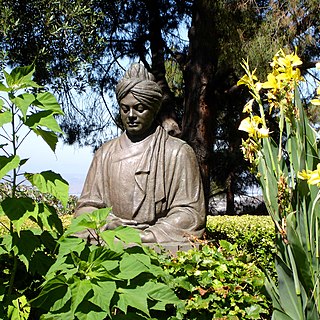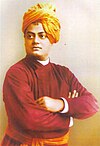
Swami Vivekananda, born Narendranath Datta, was an Indian Hindu monk and philosopher. He was a chief disciple of the 19th-century Indian mystic Ramakrishna. Influenced by Western esotericism, he was a key figure in the introduction of the Indian darsanas of Vedanta and Yoga to the Western world, and is credited with raising interfaith awareness, bringing Hinduism to the status of a major world religion during the late 19th century. He was a major force in the contemporary Hindu reform movements in India, and contributed to the concept of nationalism in colonial India. Vivekananda founded the Ramakrishna Math and the Ramakrishna Mission. He is perhaps best known for his speech which began with the words "Sisters and brothers of America ...," in which he introduced Hinduism at the Parliament of the World's Religions in Chicago in 1893.

Christopher William Bradshaw Isherwood was an Anglo-American novelist, playwright, screenwriter, autobiographer, and diarist. His best-known works include Goodbye to Berlin (1939), a semi-autobiographical novel which inspired the musical Cabaret, A Single Man (1964) adapted as a film by Tom Ford in 2009, and Christopher and His Kind (1976), a memoir which "carried him into the heart of the Gay Liberation movement".

Ramakrishna Mission (RKM) is a Hindu religious and spiritual organisation which forms the core of a worldwide spiritual movement known as the Ramakrishna Movement or the Vedanta Movement. The mission is named after and inspired by the Indian spiritual Guru Ramakrishna Paramahamsa and founded by Ramakrishna's chief disciple Swami Vivekananda on 1 May 1897. The organisation mainly propagates the Hindu philosophy of Vedanta–Advaita Vedanta and four yogic ideals– Jnana, Bhakti, Karma, and Raja yoga.

Swami Prabhavananda was an Indian philosopher, monk of the Ramakrishna Order, and religious teacher. He moved to America in 1923, founded the Vedanta Society of Southern California in 1930, and spent the rest of his life there.

Trabuco Canyon is a small unincorporated community located in the foothills of the Santa Ana Mountains in eastern Orange County, California, and lies partly within the Cleveland National Forest.

Vedanta Societies refer to organizations, groups, or societies formed for the study, practice, and propagation of Vedanta. More specifically, they often refer to branches of the Ramakrishna Mission located outside India.

Sister Gargi, born Marie Louise Burke, was a writer and an eminent researcher on Swami Vivekananda, and a leading literary figure of the Ramakrishna-Vivekananda movement. Gargi was introduced to the Ramakrishna-Vivekananda movement in 1948 by Swami Ashokananda. She is known for her six-volume work, Swami Vivekananda in the West: New Discoveries. Her New Discoveries are considered as indispensable for Swami Vivekananda research.

Swami Swahananda was a senior monk of the Ramakrishna Order of India, and the minister and spiritual leader of the Vedanta Society of Southern California from 1976 to 2012. He also led the Vivekananda Retreat, Ridgely, and the Vedanta Center of Greater Washington, DC. He joined the Ramakrishna Order in 1947 and received sannyasa, full monastic ordination, in 1956.

Sri Ramakrishna Math, Chennai is a monastic organisation for men brought into existence by Ramakrishna (1836–1886), a 19th-century saint of Bengal. The motto of the Ramakrishna Math and Ramakrishna Mission is: "For one's own salvation, and for the welfare of the world". The mutt in Chennai is the first branch center of the Ramakrishna Order in Southern India. It was started in the year 1897 by Swami Ramakrishnananda, one of the direct disciples of Ramakrishna. Besides Swami Ramakrishnananda, the Math was visited by Holy Mother Sri Sarada Devi, Swami Brahmananda, Swami Nirmalananda, Swami Shivananda, Swami Abhedananda, Swami Premananda, Swami Niranjanananda, Swami Trigunatitananda, and Swami Vijnanananda.
Pravrajika Vrajaprana is a sannyasini or pravrajika at the Vedanta Society of Southern California, affiliated with the Ramakrishna Order. She resides at Sarada Convent in Santa Barbara, CA. and a writer on Vedanta, the history and growth of the Vedanta Societies

Trigunatitananda, premonastic name Sarada Prasanna Mitra, was a direct disciple of Ramakrishna, the 19th-century Indian Hindu mystic and sant. He established the monthly Bengali magazine Udbodhan of Ramakrishna Math and later, at the behest of Vivekananda, went to America in 1902 and took charge of the San Francisco centre.

Khandana Bhava–Bandhana, or Sri Ramakrishna Aratrikam, or Sri Ramakrishna Arati,, is a Bengali song composed by Hindu monk Swami Vivekananda. The song, dedicated to the 19th-century saint Ramakrishna, was composed in 1898. It is a prayer song, based on Raga Mishra Kalyana, Tala Ferta used in Indian classical music.
Hinduism in Los Angeles made its first significant impact in the late 19th century when wandering Hindu monk Swami Vivekananda, a disciple of Ramakrishna Paramahamsa, came on his second visit to the United States. Swami Paramananda, a disciple of Swami Vivekananda, founded the Vedanta centres in Los Angeles and Boston.

Swami Vivekananda, the 19th-century Indian monk, came to Los Angeles, California in 1899 during his second visit to the West. His oratorical skills and presentation of Hindu religious tenets and comparison with other religious beliefs made him a celebrity among a wide spectrum of American audience. Between 1893—1897 and 1899—1902, he traveled widely in the US lecturing on a wide range of subjects and also established Vedanta Centers. There are such centers in many cities in the US, including many centers in California. In 1899, after delivering lectures in New York, he travelled to the western part of the United States and reached Los Angeles via Chicago. He then went on to deliver lectures in California at Oakland, San Francisco and Alameda.

Prakashananda (1874–1927) was a direct monastic disciple of Vivekananda and a swami monk of the Ramakrishna Order who played a major role in propagating and promoting the Vedanta philosophy and Vivekananda's message in India and America. He worked closely with Trigunatitananda, a direct disciple of Ramakrishna for Vedanta Society of San Francisco, later renamed as Vedanta Society of Northern California, and later became its president.
Trabuco College was an American retreat center founded by Gerald Heard and Aldous Huxley early in the Human Potential Movement near the community of Trabuco Canyon, California. Although it only operated from 1942 to 1949, it is cited as an inspiration for the Esalen Institute and is now owned and operated as the Ramakrishna Monastery by the Vedanta Society of Southern California. It now includes several buildings and covers 40 acres (160,000 m2) on the slopes of the Santa Ana Mountains near O'Neill Regional Park.

Built and dedicated in 1956, the Santa Barbara Vedanta Temple is located on a 45-acre property situated between the foothills above the City of Santa Barbara, and below the peaks of the Santa Ynez Mountains. The temple has a clear view overlooking the Pacific Ocean and the Channel Islands of California.
Swami Vidyatmananda was born John Yale. He studied under Swami Prabhavananda at the Vedanta Society of Southern California and was ordained as a monk of the Ramakrishna Mission in 1964. He traveled to India and recorded his impressions in the book, A Yankee and the Swamis: A Westerner's View of the Ramakrishna Order. He also edited the journal Vedanta and the West and compiled a selection of the teachings of Swami Vivekananda in What Religion Is: In the Words of Swami Vivekananda which contains an introduction by Christopher Isherwood. He was an assistant to Swami Ritajananda at the Centre védantique Ramakrishna in Gretz, France, where he served as the center's manager until his death on March 22, 2000, at the age of 86. He edited the magazine Vedanta and the West and corresponded with many Western intellectuals including Aldous Huxley, Christopher Isherwood, Walter de la Mare, E. M. Forster, and Gerald Heard. His autobiography The Making of a Devotee reveals his spiritual evolution.

Consecrated on September 7, 1949 by Swami Prabhavananda, the Ramakrishna Monastery is located on a 40-acre property in the rolling hills of Trabuco Canyon, California. It bears the name of the great Indian mystic, Sri Ramakrishna, founder of the Ramakrishna Order of India.

Swami Sarvapriyananda is a Hindu monk (sannyasi) belonging to the Ramakrishna Order. He is the current resident Swami and head of the Vedanta Society of New York, a position he has been serving since January 2017.














